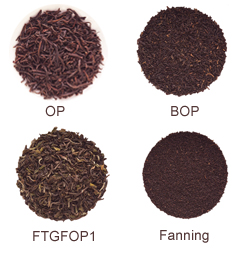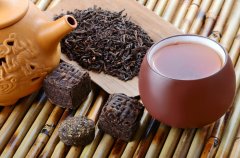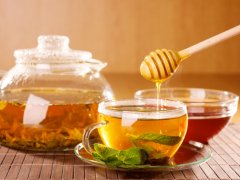How to divide the grades of black tea? Which grade of black tea tastes good? Tea grade scoring standard
The popularity of black tea in the world makes it one of the most diversified types of tea, with great differences in taste and quality. Although local and regional handmade styles create unique flavors, each farm usually produces several different levels of its own professional style. This can be confusing because different regions and tea types may use different terms.
In India, Sri Lanka and other tea industries established by the British Empire, there is a complex acronym system to describe the quality of any kind of tea. But these esoteric letter codes are often used inconsistently, and most Chinese tea producers do not recognize them. Compared with the use of these coded tags, it is easier to judge the quality of tea by looking directly at the tea.
Primary leaf
Complete leaves are graded according to their harvest date, of which golden buds are considered to be the best.
Complete tea is the highest of all teas, including black tea. Usually, whole-leaf tea is further classified according to the harvest date, and the tea harvested in early spring is considered to be the best, while the tea harvested at the end of summer is not so precious. This is because spring buds contain more natural sugar than late-harvested mature leaves, so the taste is less likely to be bitter.
Although this standard does not apply to every kind of black tea, it is valuable in both Chinese and Indian tea. In China and India, the tea with tender leaves is called "white tea" or "orange white tea", and the tea with many buds is called "sharp tea".

Broken leaf tea
Broken-leaf tea is a medium-grade tea whose flavor depends on the harvest date and soil.
Broken-leaf tea is the product of whole-leaf tea production, after the selection of the highest grade of tea. Or, especially black tea, the tea may be deliberately chopped or broken to speed up the oxidation process. Broken leaves have a larger surface area and release astringent tannins more quickly.
Like whole-leaf tea, broken-leaf tea can be made from tender buds, mature leaves, or a mixture of both, resulting in varying degrees of bitterness. The golden dried leaves are made from young buds, while black indicates late ripening. Young golden leaves indicate that tea is more naturally sweet, but broken-leaf teas are more often large, bitter, late-harvested leaves.
Tea powder
Broken-leaf tea is rough tea, while tea powder is the smallest particle.
These are the smallest particles of processed tea. Because of their small size, they are mainly used in tea bags. To ensure that only the whole piece of tea is used in the highest grade of tea, the smallest broken tea is screened from higher quality batches. Leaves harvested in the late season may also be crushed for mass production.
Even in small tea gardens that focus on high-quality production, the large harvest of mature leaves in summer brings the maximum number of fans and dust. This means that they usually have more bitterness and astringency, which can be quickly extracted from these small leaves. Fans and powders are usually mixed with spices or herbs, or made with milk and sugar, just like most mass-produced tea bags.
Each category can be further subdivided and graded, but this simple visual difference in leaf size is common in all regions and gives you a good idea of the overall quality of any black tea.
Important Notice :
前街咖啡 FrontStreet Coffee has moved to new addredd:
FrontStreet Coffee Address: 315,Donghua East Road,GuangZhou
Tel:020 38364473
- Prev

What is the reason for the bitter tea? What does tea have? What kind of tea sets are used for each of the six kinds of tea
With so many different tea styles and culturally unique brewing customs around the world, it's hard to know what equipment is best for making your favorite tea. In fact, most pots can brew almost any kind of tea. But just as geographical isolation led to the development of many different tea styles, it also created parallel developments for tea sets. Many teas complement the tea sets of nearby areas
- Next

What kind of black tea is honey-scented black tea? why does it have honey fragrance? What kind of tea tastes particularly sweet after brewing?
Although it is common for most tea drinkers in the Western world to add sweeteners to tea, tea lovers in the East have found early on that tea does not need anything extra to satisfy our desire for sweetness. It is difficult to describe these teas, however, because popular teas are made from artificial flavors or sweeteners. A tea described as having a creamy, honey or caramel flavor
Related
- Cudi stores ban other brands of coffee?! Netizen: No problem
- Is it better to make coffee cold or hot? Why is it recommended to drink hot coffee?
- Lucky people collapsed! The store ceiling is full of AI surveillance cameras?!
- Law Enforcement Bureau? Mixue Ice City enters Zhengzhou BRT platform!
- Heavy! Nestlé has been exposed to consider selling blue bottle coffee!
- Compensation of 270 million yuan! Starbucks has been charged with violating labor laws more than 500,000 times!
- What are Xizhao coffee beans? Why did they become champion beans? How to rush to the manor on the dividing line in Colombia?
- What does channel effect mean in coffee? Why are there holes in the coffee powder cake?
- How much do you add to the milk for latte, Australian white and cappuccino? What is the ratio of coffee to milk between latte and frill?
- What is the cause of coffee astringency? Why does the brewed coffee feel astringent?

